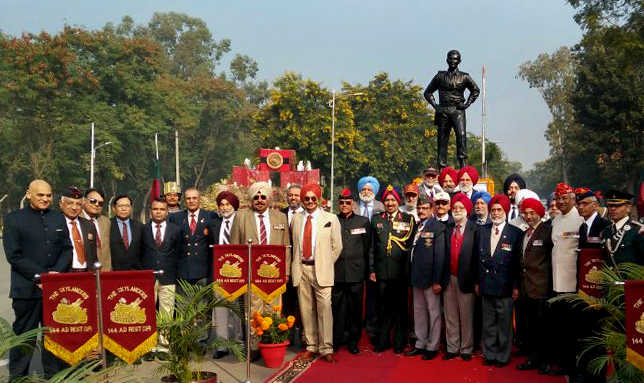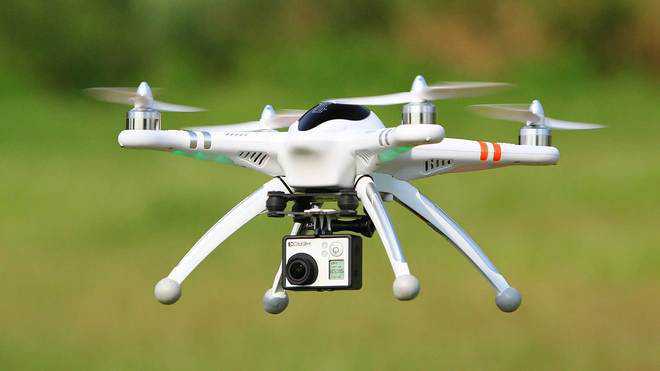











Chandigarh, December 16
To commemorate India’s historic win over Pakistan in the 1971 war, Vijay Diwas was celebrated at the Headquarters, Western Command, Chandimandir, today with full military grandeur and dignity. A solemn wreath-laying ceremony was held at the Veer Smriti war memorial in Chandimandir where the General Officer Commanding-in-Chief, Western Command, Lt Gen Surinder Singh, paid floral tributes to the martyrs.A large number of officers and other ranks attended the ceremony. Several senior retired officers who had participated in the 1971 war, including Brig Kuldip Singh Chandpuri, Lt Gen GS Sihota, Air Marshal MM Singh and Col HS Dhaliwal were also present. It was on December 16, 2017, that Pakistani forces laid down their arms before the Indian forces and Lt Gen AAK Niazi, the Pakistani commander in the east, surrendered to Lt Gen Jagjit Singh Aurora, the then GOC-in-C, Eastern Command. This led to the creation of Bangladesh as an independent nation.At another ceremony in Chandimandir, course mates of Param Vir Chakra recipient, Second Lieutenant Arun Kheterpal, paid tributes to him at his statute installed near the entrance to the military station.Belonging to the Poona Horse, he laid down his life in the battle of Basantar on the western front during the war. A fierce tank fight was fought between the Poona Horse and 13 Lancers of Pakistan on the banks of the Basantar river. Khetarpal was severally wounded during the action and was asked to abandon his tank. He refused to do so and gallantly fought destroying several enemy tanks. At this stage, his tank received a direct hit which resulted in his death.Arun’s brother Mukesh Khetrapal and 21 of his course mates from the three services, accompanied by ladies, six veterans from the Poona Horse, along with serving representatives of the unit, his instructor at the Indian Military Academy, Brigadier Dhaliwal, as well as the headmaster of the Lawrance School, Sanawar, where he had studied, were present on the occasion. — TNS
The former soldier who famously admitted to speaking lies ‘in the national interest’ is a quintessential politician who wore the uniform temporarily, and is gnawing at the political opportunities that the current chaos in Pakistan offer.

Lt-Gen Bhopinder Singh (retd)
Pervez Musharraf was commissioned in the Artillery Regiment of the Pakistan Army in 1964. The journey of the erstwhile ‘Gunner’ to that of a current-day ‘loose cannon’ has been remarkable in its dexterity, proficiency and ability to walk the tightrope of Pakistani intrigues. Musharraf’s recent comments on the internationally designated terrorist, Hafiz Saeed (with a $10-million bounty for his dastardly role in the 2008 Mumbai attacks), has surprised none of the Pakistan-watchers who noted the chameleon-like consistency in Musharraf’s admission, “I am the biggest supporter of Lashkar-e-Taiba and I know they like me, and Jamaat-ud-Dawa also likes me.” The self-claimed ‘liberal’and ‘moderate’ went on to rant, “I was always in favour of action in Kashmir and of suppressing the Indian Army in Kashmir and they (Lashkar-e-Taiba) are the biggest force.” The irony of the fact that it was Pervez Musharraf himself who, under US and Indian pressure, had banned the Lashkar-e-Taiba in 2002 was conveniently brushed aside by saying, “We had banned Lashkar-e-Taiba because the situation was different at that time. We were moving towards peace and as such I thought we should reduce ‘mujahids’ and increase political dialogue and frankly I had very less knowledge about him.” Nine years at the peak of his official political powers, first as the ‘Chief Executive of Pakistan’ (October 1999 to November 2002) and then as the ‘President of Pakistan’ (June 2001 to August 2008) have not diminished the political ambitions of the maverick former-soldier who has defied the odds and tripped his opposition, and all those who believed his sincerity (eg India in Agra) or pusillanimity (eg Nawaz Sharif who superseded two other senior officers, to install an ostensibly pliant and non-threatening ‘Mohajir’, General Pervez Musharraf as the Pakistani Chief of Army Staff in 1998).
The rise of Musharraf
The least academically promising of the three sons of a middle class family, ‘Gola’ as the rotund Musharraf was known in his childhood, bettered the obvious academic brilliance of his two other brothers (one who was an economist in Rome and the other an anesthesiologist in the US). Musharraf showed early career-agility when he moved to the ‘Special Service Group’s (SSG) Commando unit. The India-centricity was accentuated by the command of an SSG Brigade in the proximity of the Siachen Glacier, the presentation of a master’s thesis ‘Impact of Arm Race in the Indo-Pakistan subcontinent’ and then the signs of a precocious overstretch with plans to infiltrate Kargil, whilst still a Brigadier, a seed that was to germinate much later. General Zia-ul-Haq’s blue-eyed Pervez Musharraf, displayed similar behavioural traits to his early mentor Zia-ul-Haq. The master-of-disguise managed to establish his liberal and westernised perceptions by earning the nickname ‘Cowboy’ for his flamboyance, centre-split hairdo and a rare penchant for dogs with names like ‘Whiskey’ and ‘Che’ — an image decoy that hid the fact that it was the Islamist hardliner Maulana Fazl-ur-Rahman who pushed for his successive elevations. Much later, with the insecure Nawaz Sharif in the Prime Minister’s chair, Musharraf ingratiated himself with his ‘safe’ credentials (non-Punjabi and non-Pathan) and, ostensibly, apolitical bearings to take over as Pakistan’s Chief of Army Staff — an unparalleled position of power within the hierarchy of the ‘state-within-a-state’ (as the Pakistani military is known), that would haunt Nawaz Sharif within a year of his supposedly ‘safe’ decision. Musharraf’s secret ambitions blossomed and he out-muscled and outwitted Nawaz Sharif and anointed himself to creative designations of power, while still cleverly retaining the uniform as long as he could (the Chief of Army Staff who took over on October 6, 1998, handed over his baton to his protégé General Ashfaq Kayani, on November 28, 2007). The dual personality did flip-flops by undertaking Kargil misadventures and managing the optics of overture at Agra, he cozied up to the India-facing ‘Strategic Assets’ and joined the US-led ‘War on Terror’ by abandoning the ‘Afghan Assets’. He destroyed the other possible threats and suppressed the two main political parties, ie PML and PPP (though the ‘Mohajir’ MQM retained a soft spot), propped his Pakistan Muslim League (Quaid-e-Azam Group), took on the judiciary and tried reigning in ultra-conservative elements, eg Lal Chowk episode. In all, Musharraf the unlikely Chief (third in line) with a ‘Mohajir’ background, tactically aligned with the political classes till he tried removing them permanently, had a love-hate relationship with militant Islamists that saw a number of attempts on his own life, and was finally caught in the vexatious trap of juggling and pandering to too many regressive interests at the same time — the web of his vengeful actions finally drove the impression that Musharraf had duped all!
Signals of return
Today, ‘Tricky Mush’ (as General Asif Nawaz Janjua would call Musharraf for his dodgy ways) is possibly a hot potato for the Pakistani military and currently on bail in the Benazir Bhutto assassination case, with the travel-ban on him lifted. The man who consistently fooled the political parties, terrorist outfits and the allies like the US, is testing the emerging political space by aligning with the Islamists like Hafiz Saeed. With the PML-N and PPP on the back foot owing to their own misdoings, the army has already signaled its comfort with the Islamists with the recent handling of the Islamabad ‘sit-in’ and the coincidental ascendancy to chairmanship of the rickety ‘Grand Alliance of 23 parties’ is signal enough that Musharraf is planning to return to the political centerstage. The man who famously admitted to speaking lies ‘in the national interest’ is a quintessential politician who wore the uniform temporarily, and is gnawing at the political opportunities that the current chaos in Pakistan offer.

New Delhi/Beijing, December 7
An unmanned aerial vehicle (UAV) of the Indian Army crashed around Doklam in the Sikkim sector after it “crossed” the border into China following a technical problem, prompting Beijing to lodge a diplomatic protest with India.Sources in Delhi said the Indian security forces in Nathu La informed the Chinese army over the hotline about the UAV crossing the Line of Actual Control (LAC) after a technical problem.(Follow The Tribune on Facebook; and Twitter @thetribunechd)The Ministry of Defence said its border security personnel immediately alerted their Chinese counterparts to locate the UAV. The Chinese later reverted with its location. It, however, did not give details of when the UAV had crashed but sources said the incident occurred 10 days ago.The incident comes to light days before Chinese Foreign Minister Wang Yi’s visit to Delhi to attend the Russia-India-China trilateral meeting on December 11.The MoD said the exact cause of the incident is under investigation. “An Indian UAV, which was on a regular training mission inside the Indian territory, lost contact with the ground control due to some technical problem and crossed over (to) the LAC in the Sikkim sector,” it said in a statement. — PTI

























































